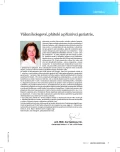Hyponatremia in older patients, specifics in diagnostics and treatment
Authors:
E. Topinková
Published in:
Geriatrie a Gerontologie 2018, 7, č. 1: 21-26
Category:
Review Article
Overview
Decreased serum sodium concentration is a rather frequent electrolyte disorder in elderly patients. The reason for this is rather frail serum sodium homeostasis, frequent presence of factors contributing to increased level of antidiuretic hormone, prescription of drugs associated with the risk of hyponatremia (particularly thiazide diuretics and antidepressants) and also other mechanisms such as nutritional i.e. the “tea and toast” syndrome.
In the diagnostic process, the first step is to evaluate the type of hyponatremia as hypovolemic, euvolemic and hypervolemic and focus on detection of individual causes, drug effect or endocrinopathies. In the syndrome of inappropriate antidiuretic hormone secretion (SIAD) a stepwise evaluation program is recommended to detect the cause and start causal treatment. In some patients, multiple causes can contribute to hyponatremia.
The management of hyponatremia depends on the type of hyponatremia. Special attention is also needed to correct serum sodium levels at the appropriate rate, especially in chronic hyponatremia to avoid the osmotic demyelination syndrome.
Keywords:
hyponatremia – elderly – SIAD – diagnosis and treatment
Sources
1. Lindner G, Pfortmuller CA, Leichtle AB, Fiedler GM, Exadaktylos AK. Age-related variety in electrolyte levels and prevalence of dysnatremias and dyskalemias in patients presenting to the emergency department. Gerontology 2014; 60(5): 420–423.
2. Hoorn EJ, Rivadeneira F, van Meurs JB, et al. Mild hyponatremia as a risk factor for fractures: the Rotterdam Study. J Bone Miner Res 2011; 26(8): 1822–1828.
3. Renneboog B, Sattar L, Decaux G. Attention and postural balance are much more affected in older than in younger adults with mild or moderate chronic hyponatremia. Eur J Intern Med 2017; 41: e25–e26.
4. Liamis G, Rodenburg EM, Hofman A, et al. Electrolyte disorders in community subjects: prevalence and risk factors. Am J Med 2013; 126(3): 256–263.
5. Mohan S, Gu S, Parikh A, Radhakrishnan J. Prevalence of hyponatremia and association with mortality: results from NHANES. Am J Med 2013; 126(12): 1127–1137.e1.
6. Weber P. Akutní poruchy elektrolytové rovnováhy In: Matějovská-Kubešová H, et al. Akutní stavy v geriatrii. Galén: Praha 2009: 132–141.
7. Tesař V, Zikán V. Poruchy elektrolytové homeostázy. In: Češka R, et al. Interna. Praha: Triton 2010: 565–573.
8. Filippatos TD, Makri A, Elisaf MS, Liamis G. Hyponatremia in the elderly: Challenges and solutions. Clin Interv Aging 2017; 12: 1957–1965.
9. Liamis G, Milionis H, Elisaf M. A review of drug-induced hyponatremia. Am J Kidney Dis 2008; 52(1): 144–153.
10. Giordano M, Ciarambino T, Castellino P, et al. Seasonal variations of hyponatremia in the emergency department: age-related changes. Am J Emerg Med 2017; 35(5): 749–752.
11. Clayton JA, Rodgers S, Blakey J. Thiazide diuretic prescription and electrolyte abnormalities in primary care. Br J Clin Pharmacol 2006; 61(1): 87–95.
12. Viramontes TS, Truong H, Linnebur SA. Antidepressant-induced hyponatremia in older adults. Consult Pharm 2016; 31(3): 139–150.
13. Greenblatt HK, Greenblatt DJ. Antidepressant-associated hyponatremia in the elderly. J Clin Psychopharmacol 2016; 36(6): 545–549.
14. Anpalahan M. Chronic idiopathic hyponatremia in older people due to syndrome of inappropriate antidiuretic hormone secretion (SIADH) possibly related to aging. J Am Geriatr Soc 2001; 49(6): 788–792.
15. Thaler SM, Teitelbaum I, Berl T. „Beer potomania“ in non-beer drinkers: effect of low dietary solute intake. Am J Kidney Dis 1998; 31(6): 1028–1031.
16. Verbalis JG, Goldsmith SR, Greenberg A, et al. Diagnosis, evaluation, and treatment of hyponatremia: expert panel recommendations. Am J Med 2013; 126(10 Suppl 1): S1–S42.
17. Assessment of hyponatraemia. BMJ Best practice. Available from: http://bestpractice.bmj.com/best-practice/monograph/57/diagnosis/step-by-step.html.
18. Ware JS, Wain LV, Channavajjhala SK, et al. Phenotypic and pharmacogenetic evaluation of patients with thiazide-induced hyponatremia. J Clin Invest 2017; 127(9): 3367–3374.
19. Rodenburg EM, Hoorn EJ, Ruiter R, et al. Thiazide-associated hyponatremia: a population-based study. Am J Kidney Dis 2013; 62(1): 67–72.
20. Sharabi Y, Illan R, Kamari Y, et al. Diuretic induced hyponatraemia in elderly hypertensive women. J Hum Hypertens 2002; 16(9): 631–635.
21. De Picker L, Van Den Eede F, Dumont G, et al. Antidepressants and the risk of hyponatremia: a class-by-class review of literature. Psychosomatics 2014; 55(6): 536–547.
22. Moritz ML, Ayus JC. Maintenance intravenous fluids in acutely ill patients. N Engl J Med. 2015; 373(14): 1350–1360.
23. Harbeck B, Lindner U, Haas CS. Low-dose tolvaptan for the treatment of hyponatremia in the syndrome of inappropriate ADH secretion (SIADH). Endocrine 2016; 53(3): 872–873.
24. Yan L, Xie F, Lu J, et al. The treatment of vasopressin V2-receptor antagonists in cirrhosis patients with ascites: a meta-analysis of randomized controlled trials. BMC Gastroenterol 2015; 15(1): 65.
25. Spasovski G, Vanholder R, Allolio B, et al. Clinical practice guideline on diagnosis and treatment of hyponatraemia. Nephrol Dial Transplant 2014; 29(Suppl 2): i1–i39.
26. Singh TD, Fugate JE, Rabinstein AA. Central pontine and extrapontine myelinolysis: a systematic review. Eur J Neurol 2014; 21(12): 1443–1450.
Labels
Geriatrics General practitioner for adults Orthopaedic prostheticsArticle was published in
Geriatrics and Gerontology

2018 Issue 1
Most read in this issue
- Hyponatremia in older patients, specifics in diagnostics and treatment
- Renal function and older age patients
- Nephropathy induced by contrast agent: do we know everything?
- Indapamide induced hyponatremia in an 83 year old patient
